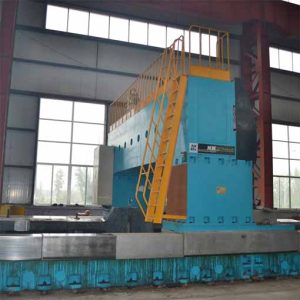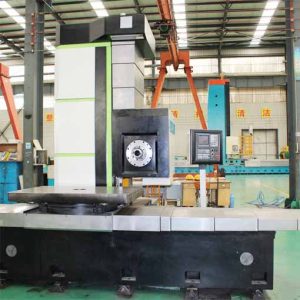Sıkıcı, frezeleme, bir deliğin veya başka bir dairesel konturun büyütülmesi için bir aletin kullanıldığı bir iç çap kesme işlemidir. Uygulamaları genellikle yarı kaba işlemeden ince talaş işlemeye kadar değişir, ve kullanılan takımlar genellikle tek kenarlı delik işleme takımlarıdır (sıkıcı çubuk araçları denir).
Boring is a type of boring and milling.
The method of processing the reverse boring hole with the reverse boring tool is called reverse boring processing.
On CNC machine tools, we often use non-standard tools (eccentric boring tools, rotating inserts, special reverse boring tools) to perform reverse boring processing using CNC machining programs.
The prefabricated hole on the workpiece is enlarged to a certain size with a rotating single-edge boring tool, so that it can achieve the required precision and surface roughness cutting. Boring is generally carried out on boring machines, machining centers and combination machines. It is mainly used for machining cylindrical holes (see picture), threaded holes, grooves in holes and end faces on workpieces such as boxes, brackets and machine bases; When special accessories are used, parçaların iç ve dış küresel yüzeyleri ve konik delikleri de işlenebilmektedir. Metal bileşenlerin delik işleme doğruluğu genellikle IT9~7'ye ulaşabilir, ve yüzey pürüzlülüğü Ra2.5~0.16 mikrondur.

Yatay freze ve delik işleme makineleri için CNC işleme hizmetleri
Sıkıcı olduğunda, iş parçası takım tezgahı masasına veya takım tezgahı fikstürüne monte edilmiştir, ve delik işleme takımı delik işleme çubuğuna kelepçelenir (aynı zamanda delik işleme barası ile de entegre edilebilir), döndürmek için iş mili tarafından tahrik edilen. Sıkıcı kalıp kullanıldığında, delik işleme çubuğu ve ana şaft yüzer şekilde bağlanmıştır, ve işleme doğruluğu delik işleme kalıbının doğruluğuna bağlıdır; Delik işleme kalıbı kullanılmadığında, delik işleme barası ve iş mili sıkı bir şekilde bağlanmıştır, ve işleme doğruluğu, takım tezgahının doğruluğuna bağlıdır. Delik işleme barasının büyük kullanma mesafesi nedeniyle, titreşim oluşturmak kolaydır, ve seçilen kesme miktarı fazla olmamalıdır. Delik işleme süreci kaba delik işlemeye ayrılmıştır, yarı ince delik işleme ve ince delik işleme. Sıradan çeliği delmek için yüksek hız çeliği kesici kafa kullanıldığında kesme hızı genellikle 20-50 m/dak; Karbür uç kullanıldığında kesme hızı, kaba sıkıcı ulaşabilir 40-60 m/dak, ve ince delik işleme daha fazlasına ulaşabilir 150 m/dak.
Yüksek hassasiyet ve yüzey pürüzlülüğü gerektiren hassas delik işleme için, genellikle elmas delme makineleri kullanılır, ve semente karbür gibi süper sert malzemelerden yapılmış takımlar, elmas ve kübik bor nitrür kullanılır. Çok küçük bir feed seçin (0.02-0.08 mm/dev) ve kesme derinliği (0.05-0.1 mm), Bu, sıradan delik işlemenin kesme hızından daha yüksektir. Hassas delik işlemenin işleme doğruluğu IT7~6'ya ulaşabilir, and the surface roughness is Ra0.63~0.08 microns. Before precision boring, prefabricated holes were subjected to rough boring, yarı ince delik işleme ve ince delik işleme, leaving a thin and uniform machining allowance for precision boring.

Machining services of gantry CNC milling and boring machine
Commonly used boring tools
Type of boring tool
According to the number of cutting edges, it can be divided into single-edged boring tools, double-edged boring tools and multi-edged boring tools; According to its machining surface, it can be divided into through hole boring tool, blind hole boring tool, stepped hole boring tool and end face boring tool; According to its structure, it can be divided into integral type, assembled type and adjustable type. Figür 1 shows the structure of a single-edge boring tool and a multi-edge boring tool.
Single edge boring tool
The structure of the single-edge boring tool head is similar to that of turning tools. The cutter head is installed in the tool holder, and the position of the cutter head is fixed with screws by manual manipulation according to the diameter of the hole being processed. The tool head is perpendicular to the axis of the boring bar to bore through holes, and the inclined installation can bore blind holes.
The single-edge boring tool has a simple structure, can correct the original hole axis deviation and small position deviation, and has a wide adaptability, which can be used for roughing, semi-finishing or finishing. Fakat, the size of the boring hole is guaranteed by manually adjusting the overhang length of the cutter head, which is troublesome. Ek olarak, only one main cutting edge participates in the work, so the production efficiency is low, and it is mostly used for single-piece small batch production.
Double edged boring tool
The double-edged boring tool has two symmetrical cutting edges, and the radial forces can cancel each other during cutting. The diameter and accuracy of the workpiece aperture are guaranteed by the radial dimension of the boring tool.
CNC boring
A boring tool has three basic elements: an indexable insert, a shank and a boring seat. The boring holder is used to hold the tool holder, and the holding length is usually about 4 times the diameter of the tool holder. The length that the insert-mounted shank extends from the boring seat is called the overhang (the unsupported part of the boring tool). Çıkıntı, delik delme deliğinin maksimum derinliğini belirler ve delik işleme takımının en önemli boyutudur. Aşırı sarkma sapın ciddi şekilde sapmasına neden olabilir, Gevezeliğe neden olmak, iş parçasının yüzey kalitesine zarar verir ve kesici ucun zamanından önce bozulmasına neden olabilir. Bunlar işleme verimliliğini azaltacaktır.
Çoğu işleme uygulaması için, kullanıcı mümkün olan en yüksek statik ve dinamik sağlamlığa sahip bir delik işleme takımı seçmelidir. Statik sertlik, delik işleme takımının kesme kuvvetinin neden olduğu sapmaya dayanma yeteneğini yansıtır, ve dinamik sertlik, delik işleme takımının titreşimi bastırma yeteneğini yansıtır.
Bu makalenin ilk kısmı temel olarak delik işleme takımının statik sertliğini analiz etmektedir. The information in this paper comes from the author’s research on the deflection of the boring tool. The deflection of the boring tool depends on the mechanical properties of the shank material, shank diameter and cutting conditions.
kesme kuvveti
The cutting force acting on the boring tool can be measured with a rotating dynamometer. The measured forces include tangential force, feed force and radial force. Compared to the other two forces, the tangential force has the largest magnitude.
The tangential force acts perpendicular to the rake face of the insert and pushes the boring tool down. It is important to note that the tangential force acts near the tip of the insert and not on the center axis of the shank. The deviation of the tangential force from the centerline creates a moment arm (the distance from the centerline of the shank to the point of force), which creates a moment that causes the boring tool to twist relative to its centerline.
The feed force is the second largest force and acts parallel to the centerline of the shank, so it does not cause deflection of the boring tool. The radial force acts perpendicular to the centerline of the shank and pushes the boring tool away from the surface being machined.
Öyleyse, only tangential and radial forces will deflect the boring tool. An empirical algorithm that has been used for decades is: The feed force and radial force are about 25% Ve 50% of the tangential force, respectively. Today, Yine de, this proportional relationship is not considered an “optimal algorithm” Çünkü bireysel kesme kuvvetleri arasındaki ilişki spesifik iş parçası malzemesine ve sertliğine bağlıdır, kesme koşulları, ve burun yarıçapı.

Planya tipi freze ve delik delme makinesi için CNC işleme hizmeti
Delik işleme takımı sapması
Delik işleme takımı, bir ucu sabit olan konsol kirişine benzer (sıkıcı koltuk sıkıştırma parçası) ve diğer uç desteklenmiyor (araç çubuğu çıkıntısı), böylece delik işleme takımının sapması konsol kiriş sapması hesaplama formülüyle hesaplanabilir:
y=(F×L3)/(3E×I)
Formülde: F bileşke kuvvettir; L çıkıntıdır (birim: inç); E elastik modüldür (yani, takım sapı malzemesinin Young modülü) (birim: psi, inç kare başına pound);
I takım tutucu bölümünün atalet momentidir (birim: inç4).
The formula for calculating the moment of inertia of the section of the boring bar is:
I=(π×D4)/64
Nerede: D is the outer diameter of the boring bar (birim: inç).
Example of deflection calculation of boring tool:
Processing conditions:
Workpiece material: AISI 1045 karbon çelik, hardness HB250;
Depth of cut: 0.1″,
Feed: 0.008 inches/rev;
Shank diameter: 1″,
The elastic modulus of the blade: E=30×106psi,
The overhang of the shank: 4″.
(1) Calculation of tangential force
Ft=396000×depth of cut×feed rate×power constant=396000×0.1×0.008×0.99=313.6 lbs
(2) Calculation of radial force
Fr=0.308×Ft=0.308×313.6=96.6 lbs
(3) Calculation of resultant force
F=328.1 lbs
(4) Calculation of the moment of inertia of the section:
I=(π×D4)/64=0.0491 in.4
(5) Calculation of the deflection of the boring tool
y=(F×L3)/(3E×I)=0.0048″
Sondaj takımının sapması ve kesitin atalet momentinin hesaplama formülleri analiz edilir. Sıkma yaparken aşağıdaki ilkelere uyulmalıdır:
(1) Delik işleme takımının çıkıntısı mümkün olduğu kadar küçük olmalıdır. Çünkü çıkıntı arttıkça, sapma da artar. Örneğin, çıkıntı bir kat arttığında 1.25, sapma neredeyse bir kat artacak 2 sap dış çapı ve kesme parametreleri aynı kalırken.
(2) Delik işleme çubuğunun çapı mümkün olduğu kadar büyük olmalıdır. Çünkü sapın çapı arttığında, bölümünün eylemsizlik momenti de artacaktır, ve sapma miktarı azalacaktır. Örneğin, sapın çapı bir kat arttığında 1.25, sapma neredeyse bir kat azalacak 2.5 aynı kullanma mesafesi ve kesme parametreleriyle.
(3) Çıkıntı olduğunda, takım çubuğunun dış çapı ve kesme parametreleri değişmeden kalır, yüksek elastik modüllü malzemeye sahip delik işleme barasının kullanılması sapmayı azaltabilir.
 English
English العربية
العربية 中文(漢字)
中文(漢字) Čeština
Čeština Dansk
Dansk Nederlands
Nederlands Suomi
Suomi Français
Français Deutsch
Deutsch Italiano
Italiano 日本語
日本語 ಕನ್ನಡ
ಕನ್ನಡ 한국어
한국어 Português
Português Русский
Русский Slovenčina
Slovenčina Español
Español Svenska
Svenska Türkçe
Türkçe

